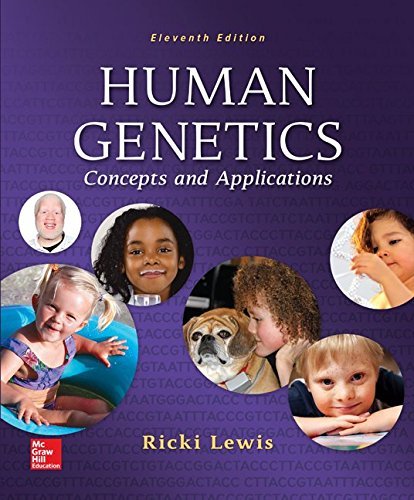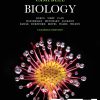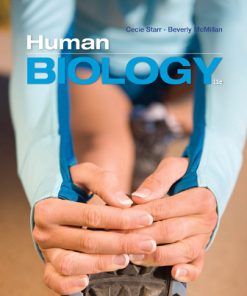Human Genetics Lewis 11th Edition Test Bank
$35.00 Original price was: $35.00.$26.50Current price is: $26.50.
Human Genetics Lewis 11th Edition Test Bank
Instant download Human Genetics Lewis 11th Edition Test Bank pdf docx epub after payment.

Chapter 01
What is in a Human Genome?
Multiple Choice Questions
- Genetics is the study of
A.variation of inherited traits.
B. how organisms reproduce.
C. how life originated.
D. how the environment causes disease.
Bloom’s Level: 01. Remember
Learning Outcome: 01.01 Explain what genetics is, and what it is not.
Section: 01.01
Topic: Genes and genomes
- In which choice are the entries listed from smallest to largest?
A.DNA building block – gene – chromosome – genome
B. DNA building block – RNA building block – protein
C. Gene – cell – DNA – genome
D. Chromosome – genome – cell – DNA building block
Bloom’s Level: 02. Understand
Learning Outcome: 01.02 Distinguish between gene and genome.
Section: 01.01
Topic: Genes and genomes
- The complete genetic material of an organism is its
A.genome.
B. chromosome.
C. phenotype.
D. genotype.
Bloom’s Level: 02. Understand
Learning Outcome: 01.02 Distinguish between gene and genome.
Section: 01.01
Topic: Genes and genomes
The number of copies of our genome in most of our cells is _____.
- 1
B. 2
C. 3
D. 4
Bloom’s Level: 01. Remember
Learning Outcome: 01.02 Distinguish between gene and genome.
Section: 01.01
Topic: Genes and genomes
- An estimated _____ DNA base pairs comprise the human genome.
A.32,000
B. 320,000
C. 3.2 million
D. 3.2 billion
Bloom’s Level: 01. Remember
Learning Outcome: 01.02 Distinguish between gene and genome.
Section: 01.01
Topic: Genes and genomes
- _____ was founded in the 1970s to address moral issues and controversies that arise in applying medical technology.
A.
Metaethics
Bioethics
Biotechnology
Genetics
Bloom’s Level: 01. Remember
Learning Outcome: 01.03 Define bioethics.
Section: 01.01
Topic: Genes and genomes
- Variants of a gene are called
A.genotypes.
B. phenotypes.
C. alleles.
D. single nucleotide polymorphisms.
Bloom’s Level: 01. Remember
Learning Outcome: 01.04 Describe the levels of genetics, from nucleic acids to chromosomes, to cells, body parts, families, and populations.
Section: 01.02
Topic: Levels of genetics
Humans have _____ pairs of chromosomes.
- 23
B. 38
C. 46
D. 32
Bloom’s Level: 01. Remember
Learning Outcome: 01.04 Describe the levels of genetics, from nucleic acids to chromosomes, to cells, body parts, families, and populations.
Section: 01.02
Topic: Levels of genetics
- A change in a gene’s DNA sequence is a(n)
A.genotype.
B. nucleotide.
C. mutation.
D. genome.
Bloom’s Level: 02. Understand
Learning Outcome: 01.04 Describe the levels of genetics, from nucleic acids to chromosomes, to cells, body parts, families, and populations.
Section: 01.02
Topic: Levels of genetics
- In general, RNA molecules
A.comprise the chromosomes.
B. use the information in specific DNA sequences to construct proteins.
C. entwine with DNA molecules to encode proteins.
D. form double helices that encode DNA sequences.
Bloom’s Level: 02. Understand
Learning Outcome: 01.04 Describe the levels of genetics, from nucleic acids to chromosomes, to cells, body parts, families, and populations.
Section: 01.02
Topic: Levels of genetics
- A genotype refers to
A.particular allele combinations.
B. expression patterns of certain genes.
C. the environmental components of a trait.
D. the number of chromosomes that a person has.
Bloom’s Level: 02. Understand
Learning Outcome: 01.04 Describe the levels of genetics, from nucleic acids to chromosomes, to cells, body parts, families, and populations.
Section: 01.02
Topic: Levels of genetics
A chart that displays paired chromosomes in order of size is a
- phenotype.
B. genotype.
C. karyotype.
D. genome.
Bloom’s Level: 02. Understand
Learning Outcome: 01.04 Describe the levels of genetics, from nucleic acids to chromosomes, to cells, body parts, families, and populations.
Section: 01.02
Topic: Levels of genetics
- A human cell has
A.22 pairs of sex chromosomes and one pair of autosomes.
B. 22 pairs of autosomes and one pair of sex chromosomes.
C. 23 pairs of autosomes.
D. 23 pairs of autosomes and a pair of Y chromosomes.
Bloom’s Level: 01. Remember
Learning Outcome: 01.04 Describe the levels of genetics, from nucleic acids to chromosomes, to cells, body parts, families, and populations.
Section: 01.02
Topic: Levels of genetics
Chromosome Y
forms the somatic cells.
is a sex chromosome.
contains discontinuous DNA sequence.
is present in all humans.
Bloom’s Level: 02. Understand
Learning Outcome: 01.04 Describe the levels of genetics, from nucleic acids to chromosomes, to cells, body parts, families, and populations.
Section: 01.02
Topic: Levels of genetics
Polydactyly is considered a Mendelian trait as
it is caused by linked genes.
it is caused by a single gene.
it is caused due to environmental factors.
it affects the stem cells.
Bloom’s Level: 02. Understand
Learning Outcome: 01.04 Describe the levels of genetics, from nucleic acids to chromosomes, to cells, body parts, families, and populations.
Section: 01.02
Topic: Levels of genetics
- Which of the following traits is considered Mendelian?
A.
A trait which is caused by linked genes
A trait which is caused by a single gene
A trait which is caused by environmental factors
A trait which is multifactorial
Bloom’s Level: 01. Remember
Learning Outcome: 01.04 Describe the levels of genetics, from nucleic acids to chromosomes, to cells, body parts, families, and populations.
Section: 01.02
Topic: Levels of genetics
- One way to study the human genome is to
A.determine the twisting patterns of the two sides of the double helix.
B. determine the sequence of sugars and phosphates.
C. determine the DNA sequence.
D. conduct a phenotype-wide association study.
Bloom’s Level: 02. Understand
Learning Outcome: 01.04 Describe the levels of genetics, from nucleic acids to chromosomes, to cells, body parts, families, and populations.
Section: 01.02
Topic: Levels of genetics
During DNA replication, to produce protein, a process called transcription copies the sequence of part of one strand of a DNA molecule into a related molecule, known as _____.
- genes.
B. mRNAs.
C. proteins.
D. genomes.
Bloom’s Level: 01. Remember
Learning Outcome: 01.04 Describe the levels of genetics, from nucleic acids to chromosomes, to cells, body parts, families, and populations.
Section: 01.02
Topic: Levels of genetics
A human body has about _____ cells.
- 3.2 billion
B. 20,600
C.
37 trillion
- 10 to 100 million
Bloom’s Level: 01. Remember
Learning Outcome: 01.04 Describe the levels of genetics, from nucleic acids to chromosomes, to cells, body parts, families, and populations.
Section: 01.02
Topic: Levels of genetics
- The four basic tissue types are
A.blood cells, skin cells, neurons, and muscle cells.
B. adipose cells, muscle cells, bone cells, and sex cells.
C. connective tissue, epithelium, muscle, and nervous tissue.
D. the stomach, the small intestine, the liver, and the pancreas.
Bloom’s Level: 01. Remember
Learning Outcome: 01.04 Describe the levels of genetics, from nucleic acids to chromosomes, to cells, body parts, families, and populations.
Section: 01.02
Topic: Levels of genetics
- Cells differentiate by
A.expressing different subsets of genes.
B. expressing the entire genome, then silencing some genes.
C. activating all of the DNA that encodes protein.
D. becoming stem cells.
Bloom’s Level: 02. Understand
Learning Outcome: 01.04 Describe the levels of genetics, from nucleic acids to chromosomes, to cells, body parts, families, and populations.
Section: 01.02
Topic: Levels of genetics
- The difference between phenotype and genotype is that
A.phenotype refers to the genetic instructions and genotype to their expression.
B. genotype refers to the genetic instructions and phenotype to their expression.
C. the phenotype is RNA and the genotype is DNA.
D. the phenotype is DNA and the genotype is RNA.
Bloom’s Level: 02. Understand
Learning Outcome: 01.04 Describe the levels of genetics, from nucleic acids to chromosomes, to cells, body parts, families, and populations.
Section: 01.02
Topic: Levels of genetics
- Shawn’s mother and Heather’s mother are sisters. Shawn and Heather have __ of their genes in common.
A.1/2
B. 1/4
C. 1/8
D. 1/16
Bloom’s Level: 04. Analyze
Learning Outcome: 01.04 Describe the levels of genetics, from nucleic acids to chromosomes, to cells, body parts, families, and populations.
Section: 01.02
Topic: Levels of genetics
- A gene pool consists of all the alleles in a(n)
A.population.
B. individual.
C. family.
D. neighborhood.
Bloom’s Level: 02. Understand
Learning Outcome: 01.05 Explain how genetics underlies evolution.
Section: 01.02
Topic: Levels of genetics
- A trait or disorder that is multifactorial is
A.present in more than one family member.
B. found only in one part of the world.
C.
caused by one or more genes and environmental influences.
- caused by a single gene, with no environmental input.
Bloom’s Level: 02. Understand
Learning Outcome: 01.04 Describe the levels of genetics, from nucleic acids to chromosomes, to cells, body parts, families, and populations.
Section: 01.03
Topic: Levels of genetics
- Kanisha and her friend both receive their grades for their physics midterms. Kanisha got an A, but her friend received a D. “You must have the physics gene,” remarks her friend. “I don’t. I might as well not bother studying.” The friend’s attitude illustrates the idea of
A.genetic discrimination.
B. genetic determinism.
C. genetic engineering.
D. genetic modification.
Bloom’s Level: 04. Analyze
Learning Outcome: 01.04 Describe the levels of genetics, from nucleic acids to chromosomes, to cells, body parts, families, and populations.
Section: 01.02
Topic: Levels of genetics
- Body weight must be a multifactorial trait because
A.it is obviously inherited.
B. it responds to lifestyle changes.
C. it is within a certain range.
D. it is inherited to an extent, but can be altered by diet and/or exercise.
Bloom’s Level: 02. Understand
Learning Outcome: 01.04 Describe the levels of genetics, from nucleic acids to chromosomes, to cells, body parts, families, and populations.
Section: 01.02
Topic: Levels of genetics
- The distinction between mutations and gene expression is that
A.mutations affect only autosomes and gene expression affects only sex chromosomes.
B. mutations are dangerous and gene expression promotes health.
C. mutations are changes in the DNA sequence, whereas gene expression refers to the extent to which a gene is transcribed and translated, producing protein.
D. gene expression refers to changes in the DNA sequence, whereas mutation refers to the processes of DNA replication, RNA transcription, and protein synthesis.
Bloom’s Level: 02. Understand
Learning Outcome: 01.04 Describe the levels of genetics, from nucleic acids to chromosomes, to cells, body parts, families, and populations.
Section: 01.02
Topic: Levels of genetics
- Constructing a “diseasome” is a way to connect diseases that share certain gene expression patterns. A goal of this approach is to
A.cure cancer.
B. identify new drug targets.
C. cure all diseases that involve the same set of genes.
D.
discover how our ancestors were related.
Bloom’s Level: 02. Understand
Learning Outcome: 01.04 Describe the levels of genetics, from nucleic acids to chromosomes, to cells, body parts, families, and populations.
Section: 01.02
Topic: Levels of genetics
Identifying individual drug reactions based on genetics is a growing field called
genetic mapping.
pharmacogenetics.
genetic determinism.
- applied pharmacology.
Bloom’s Level: 04. Analyze
Learning Outcome: 01.04 Describe the levels of genetics, from nucleic acids to chromosomes, to cells, body parts, families, and populations.
Section: 01.03
Topic: Levels of genetics
- A test performed on secretions on a piece of fabric left at a crime scene that is used to implicate an apprehended suspect is
A.DNA replication.
B. RNA transcription.
C. DNA profiling.
D. DNA sharing.
Bloom’s Level: 03. Apply
Learning Outcome: 01.06 Provide examples of how genetics is used in identification of people and in health care.
Section: 01.03
Topic: DNA testing in history, forensics, and health care
- Nacho suffers from terrible migraine headaches. He enters a clinical trial to test whether certain single nucleotide polymorphisms (SNPs) are associated with response to one drug but not another. This is an approach called
A.gene therapy.
B.
pharmacogenetics.
- genetic determinism.
D.applied pharmacology.
Bloom’s Level: 04. Analyze
Learning Outcome: 01.04 Describe the levels of genetics, from nucleic acids to chromosomes, to cells, body parts, families, and populations.
Section: 01.03
Topic: Levels of genetics
DNA profiling has been used to
2-14-2013
- identify victims of terrorist attacks and natural disasters.
B. cure metabolic diseases caused by mutations in single genes.
C. treat male infertility.
D. predict how children will do in school.
Bloom’s Level: 01. Remember
Learning Outcome: 01.06 Provide examples of how genetics is used in identification of people and in health care.
Section: 01.03
Topic: DNA testing in history, forensics, and health care
DNA profiling is helpful in
2-14-2013
curing cancer.
analyzing food.
treating male infertility.
preventing male pattern baldness.
Bloom’s Level: 01. Remember
Learning Outcome: 01.06 Provide examples of how genetics is used in identification of people and in health care.
Section: 01.03
Topic: DNA testing in history, forensics, and health care
- One way that single-gene diseases differ from other diseases is that
A.they affect consecutive generations.
B. they occur at the same frequency in every population.
C. they are not treatable.
D. it is possible to predict occurrence in specific relatives.
Bloom’s Level: 02. Understand
Learning Outcome: 01.06 Provide examples of how genetics is used in identification of people and in health care.
Section: 01.03
Topic: DNA testing in history, forensics, and health care
- Why is possible to detect the mutation causing Huntington disease at any age?
A.
It is possible to detect the mutation causing Huntington disease at any age because it is a single-gene disorder.
It is possible to detect the mutation causing Huntington disease at any age because it affects consecutive generations.
It is possible to detect the mutation causing Huntington disease at any age because it is caused by the mutation of linked genes.
It is possible to detect the mutation causing Huntington disease at any age because it is influenced by the immediate environment.
Bloom’s Level: 02. Understand
Learning Outcome: 01.06 Provide examples of how genetics is used in identification of people and in health care.
Section: 01.03
Topic: DNA testing in history, forensics, and health care
_____ refers to whether a gene is “turned on” or “turned off” from being transcribed and translated into protein.
2-14-2013
Gene mutation
Gene expression
Gene sequence
Gene pool
Bloom’s Level: 01. Remember
Learning Outcome: 01.06 Provide examples of how genetics is used in identification of people and in health care.
Section: 01.03
Topic: DNA testing in history, forensics, and health care
- _____ is a field that is revealing and describing much of the invisible living world by sequencing all of the DNA in a particular habitat.
A.
Stem cell science
Bioethics
Metagenomics
Biochemistry
Bloom’s Level: 01. Remember
Learning Outcome: 01.07 How can investigating genomes extend beyond interest in ourselves?
Section: 01.04
Topic: DNA testing in history, forensics, and health care
- Sequencing all the DNA in the fluid that leaks from the bottom of a garbage can is an example of
A.stem cell science.
B. gene expression profiling.
C. metagenomics.
D. DNA profiling.
Bloom’s Level: 02. Understand
Learning Outcome: 01.07 How can investigating genomes extend beyond interest in ourselves?
Section: 01.04
Topic: DNA testing in history, forensics, and health care
How do researchers in the metagenomics sector operate?
They study Mendelian traits in children.
They link diseases by shared gene expression.
They detect mutations in the protein encoding part of an individual’s genome by using powerful algorithms.
They collect and sequence DNA, then consult databases of known genomes to imagine what the organisms to which the DNA belongs might be like.
Bloom’s Level: 02. Understand
Learning Outcome: 01.07 How can investigating genomes extend beyond interest in ourselves?
Section: 01.04
Topic: DNA testing in history, forensics, and health care












